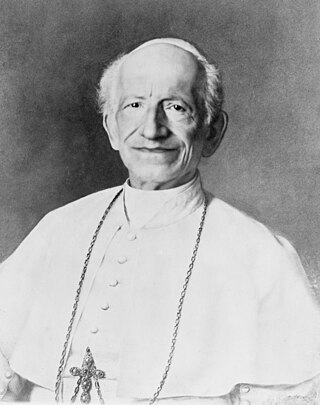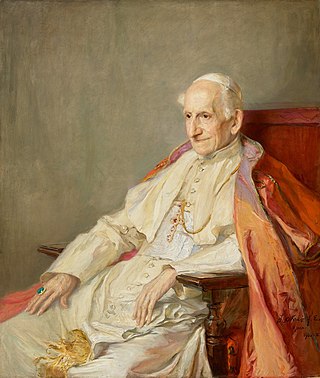
Pope Leo XIII was head of the Catholic Church from 20 February 1878 until his death in July 1903. Living until the age of 93, he was the oldest pope whose age can be validated, and had the fourth-longest reign of any pope, behind those of Peter the Apostle, Pius IX and John Paul II.

The Eastern Catholic Churches or Oriental Catholic Churches, also called the Eastern-Rite Catholic Churches, Eastern Rite Catholicism, or simply the Eastern Churches, are 23 Eastern Christian autonomous particular churches of the Catholic Church in full communion with the pope in Rome. Although they are distinct theologically, liturgically, and historically from the Latin Church, they are all in full communion with it and with each other. Eastern Catholics are a minority within the Catholic Church; of the 1.3 billion Catholics in communion with the pope, approximately 18 million are members of the eastern churches. The largest numbers of Eastern Catholics are found in Eastern Europe, Eastern Africa, the Middle East, and India. As of 2022, the Syro-Malabar Church is the largest Eastern Catholic Church, followed by the Ukrainian Greek Catholic Church.
An encyclical was originally a circular letter sent to all the churches of a particular area in the ancient Roman Church. At that time, the word could be used for a letter sent out by any bishop. The word comes from the Late Latin encyclios. The term is now primarily associated with papal encyclicals.

The Melkite Greek Catholic Church, or Melkite Byzantine Catholic Church, is an Eastern Catholic church in full communion with the Holy See as part of the worldwide Catholic Church. Its chief pastor is Patriarch Youssef Absi, headquartered at the Cathedral of Our Lady of the Dormition in Damascus, Syria. The Melkites, who are Byzantine Rite Catholics, trace their history to the early Christians of Antioch, formerly part of Syria and now in Turkey, of the 1st century AD, where Christianity was introduced by Saint Peter.
In Christianity, inculturation is the adaptation of Christian teachings and practices to cultures. This is a term that is generally used by Catholics and the Orthodox, whereas Protestants, especially associated with the World Council of Churches, prefer to use the term "contextual theology".

Alphabetical list of Eastern Christianity-related articles on English Wikipedia

The Catholic Church in Turkey is part of the worldwide Catholic Church, under the spiritual leadership of the Pope and the canonical leadership of the curia in Rome that is submitted to the Pope.

The Priestly Society of Saint Josaphat Kuntsevych (SSJK) is a society of traditionalist priests and seminarians originating from the Ukrainian Greek Catholic Church which is led by the excommunicated priest Basil Kovpak. It is based in Riasne, Lviv, Western Ukraine. In Lviv, the society maintains a seminary, at which currently thirty students reside, and takes care of a small convent of Basilian sisters. The SSJK is affiliated with the Society of St. Pius X and Holy Orders are conferred by the latter society's bishops in the Roman Rite. The SSJK clergymen, however, exclusively follow a version of Slavonic Byzantine Rite in the Ruthenian recension.
Latinisation ofliturgy refers to the process by which non-Latin Christian traditions, particularly those of Eastern Churches, adopted elements of the Latin Church's liturgical practices, theology, and customs. This phenomenon was often driven by ecclesiastical or political pressures and has left a lasting impact on global Christianity, sparking both unity and controversy. While it facilitated closer ties with the Roman Catholic Church, it also led to the suppression of local liturgical traditions and significant debates over ecclesial identity.
Elias Zoghby was an Egyptian-born Lebanese Catholic prelate who served as Archbishop of Baalbek in the Melkite Greek Catholic Church from 1968 to 1988. He was known as a leading advocate of Catholic–Orthodox ecumenism. He is best known for his ecumenical interventions during the Second Vatican Council and for his 1995 Profession of Faith, known as the Zoghby Initiative, which attempted to re-establish communion between the Melkite Greek Catholic Church and the Eastern Orthodox Church.

Cyril VIII Geha, was patriarch of the Melkite Greek Catholic Church from 1902 until 1916. He was the last Melkite Catholic patriarch of the Ottoman era.
Patriarch Cyril VI Tanas, also known as Cyril VI of Antioch, became the first Patriarch of Antioch and All the East, and Alexandria and Jerusalem of the Melkite Greek Catholic Church following the schism of the Greek Orthodox Patriarchate of Antioch in 1724. Cyril re-established full communion with the Catholic Church.

Patriarch Gregory II Youssef, also known as Gregory II Hanna Youssef-Sayour, was Patriarch of the Melkite Greek Catholic Church from 1864 to 1897. Gregory expanded and modernized the church and its institutions and participated in the First Vatican Council, where he championed the rights of the Eastern Catholic Churches.

Mor Ignatius Behnam II Benni (1831–1897) was Patriarch of the Syriac Catholic Church from 1893 to 1897.
Orientalium may refer to:

The theology of Pope Leo XIII was influenced by the ecclesial teachings of the First Vatican Council (1869-1870), which had ended only eight years before his election in 1878. Leo issued some 46 apostolic letters and encyclicals dealing with central issues in the areas of marriage and family and state and society.

Several differences exist within the organizational structures and governance of the Catholic Church and the Eastern Orthodox Church. These are distinguished from theological differences which are differences in dogma and doctrine. A number of disagreements over matters of ecclesiology developed slowly between the Western and Eastern wings of the State church of the Roman Empire centered upon the cities of Rome and New Rome/Constantinople respectively. The disputes were a major factor in the formal East-West Schism between Pope Leo IX and Patriarch Michael I in 1054 and are largely still unresolved between the churches today.
The Pontifical Greek College of St. Athanasius is a Pontifical College in Rome that observes the Byzantine rite.

The Cathedral of the Annunciation of the Virgin, also called Greek Catholic Melkite Cathedral of the Annunciation of the Virgin or simply Church of Our Lady of the Annunciation, is a Melkite Greek Catholic cathedral located in the Christian Quarter of the Old City of Jerusalem. It is dedicated to the Annunciation.
The Eastern Catholic Churches of the Catholic Church utilize liturgies originating in Eastern Christianity, distinguishing them from the majority of Catholic liturgies which are celebrated according to the Latin liturgical rites of the Latin Church. While some of these sui iuris churches use the same liturgical ritual families as other Eastern Catholic churches and Eastern churches not in full communion with Rome, each church retains the right to institute its own canonical norms, liturgical books, and practices for the ritual celebration of the Eucharist, other sacraments, and canonical hours.












